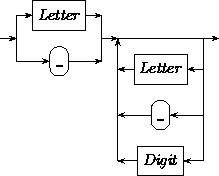|
|
|
|
|
| (Common Basis: ...) | Contents | Index | (Source Code Components) |
Sometimes it makes things easier
to use names
for more general classes than
given by the grammatical rules:
The union of IntExpression, StringExpression,
CellExpression and BoolExpression, for example,
we will call
Expression. Analogously we get
the classes Var and
ConstantIdentifier.
Instead of one or more objects of an arbitrary class Class separated by commas, we will sometimes write ClassList.
As soon as the syntax of a class consists of more than one terminal or non-terminal symbol, we give a syntax diagram to clarify the structure: Terminal symbols appear in ovals, while non-terminals are framed by rectangles. (In addition, terminals are always printed in typewriter font unlike the non-terminals which appear in the normal but italic font.)

A path through the graph which leads to valid grammatical objects starts with the arrow at the very left side, and follows always the direction pointed out by the arrows, until it ends at the point of the arrow on the right. We get an element of the described class by writing the terminal and non-terminal symbols one behind each other in right the order we passed them on a path through the diagram. The single symbols should usually be separated by blanks.
Sometimes there will be phrases like ''There can be an arbitrary amount of objects...''. Then we mean, of course, that the number is only restricted by the size of the available saving medium.
|
|
|
|
|
| (Common Basis: ...) | Contents | Index | (Source Code Components) |